How Scales Measure Up: A Look At Juvenile Salmon Scales As An Indicator Of Length & Growth
When making informed decisions regarding the management of fish stocks, information about how fish grow is crucial. However, current methods of retrieving growth data are lethal and time-consuming. The purpose of this study was to identify a new method for monitoring length and growth in juvenile Chinook Salmon (Oncorhynchus tshawytscha). Similar to trees, salmon deposit rings on their scales as they grow. This research was aimed at whether these ring patterns, (called ‘circuli patterns’) are an accurate indicator of length and growth within juvenile Chinook salmon. To investigate this, I interned with the National Oceanic Atmospheric Administration at their Northwest Fisheries Science Center, where I was responsible for the processing of fish scales, along with analyzing and modeling fish data. Samples were collected from a pre-existing set of Wild Spring-Summer Chinook salmon parr from Valley Creek (Idaho, USA). Results indicated a strong relationship between the length of the fish and the size (radius) of their scales. As fish deposit more and more rings, results indicated that the space between rings will get smaller. Collective results signify juvenile salmon scales can in fact be used as an indicator of length and growth. The outcomes of this project can guide the direction researchers may take regarding advancing this methodology. If this method continues to present as an accurate index, it will implement researchers with more access to sampling endangered wild populations and continue the application of this methodology to related stocks.
